Overview
The essential decommissioning guidelines for wind farms encompass critical safety protocols, thorough environmental assessments, proactive stakeholder engagement, and the strategic utilization of technology to guarantee a systematic and responsible dismantling process. Adhering to these guidelines not only safeguards personnel and the environment but also cultivates community trust and enhances operational efficiency. This underscores the necessity of comprehensive planning and the deployment of advanced tools, which are vital in achieving successful decommissioning outcomes.
Introduction
Navigating the complexities of wind farm decommissioning demands a strategic approach, as energy producers encounter a multitude of challenges ranging from legal hurdles to environmental impacts. This article explores nine essential guidelines that not only streamline the decommissioning process but also bolster safety, sustainability, and community engagement. With growing scrutiny on environmental practices and regulatory compliance, stakeholders must consider: how can their decommissioning efforts align with both industry standards and community expectations?
Harbinger Land: Comprehensive Solutions for Land Services in Wind Farm Decommissioning
Harbinger Land addresses the critical challenges faced by energy producers in the land acquisition process, particularly during the dismantling of energy projects. The complexities of legal and regulatory hurdles can hinder progress, making it essential to have a partner that understands these intricacies.
Their comprehensive suite of services includes:
- Site and right-of-way acquisition
- Advanced title research
- GIS mapping
- Efficient data processing
By leveraging cutting-edge technology, such as AI-powered title research software and integrated GIS modeling services, Harbinger Land significantly enhances efficiency and accuracy in managing land-related challenges in accordance with the decommissioning guidelines for wind farms.
With their GIS mapping services, clients gain enhanced visibility into all facets of a project, which facilitates real-time decision-making—an essential component for energy producers and stakeholders. Additionally, Harbinger Land's document imaging solutions streamline title research and leasing processes, ensuring a clean chain of title that mitigates risks.
The experienced team at Harbinger Land is adept at swiftly utilizing resources to meet project requirements, guaranteeing prompt and accurate services tailored to the distinct needs of energy producers and stakeholders. In a landscape where effective land management is paramount, partnering with Harbinger Land ensures that your projects progress smoothly and efficiently.
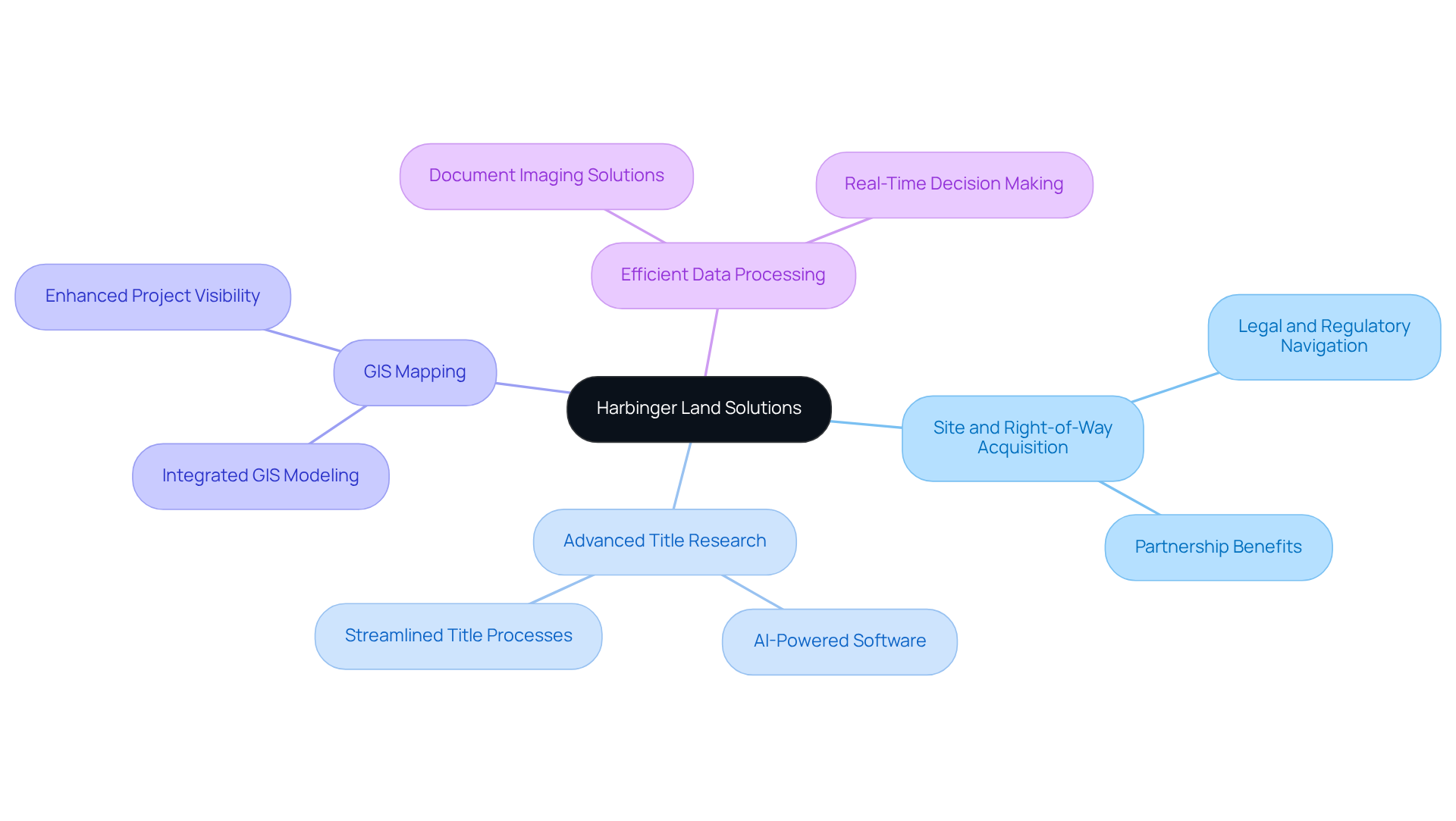
Adhere to Safety Protocols: Essential Practices for Wind Farm Decommissioning
Ensuring adherence to protocols during wind farm dismantling is vital for protecting personnel and avoiding accidents. The complexities involved in this process necessitate extensive risk evaluations to recognize possible dangers. Detailed training programs tailored for decommissioning activities are essential, alongside strict precautionary measures such as fall protection systems and emergency response plans. Routine inspections and compliance evaluations are crucial to verify conformity with local and federal regulations.
The tragic incident at Orsted's Plum Creek wind farm, where two maintenance workers lost their lives due to equipment failure, underscores the importance of strict protective measures. Tory Mazzola, Head of US Communications and Public Affairs, expressed sympathies to the families of the departed technicians, emphasizing the significance of security in the industry. This incident serves as a stark reminder of the need for unwavering commitment to safety.
Specialists advocate for ongoing enhancement in training initiatives, highlighting the necessity for an environment that prioritizes worker well-being. By incorporating these best practices, the industry can not only improve safety outcomes but also significantly reduce risks associated with dismantling operations. The call to action is clear: prioritize safety to protect lives and ensure the integrity of the dismantling process.
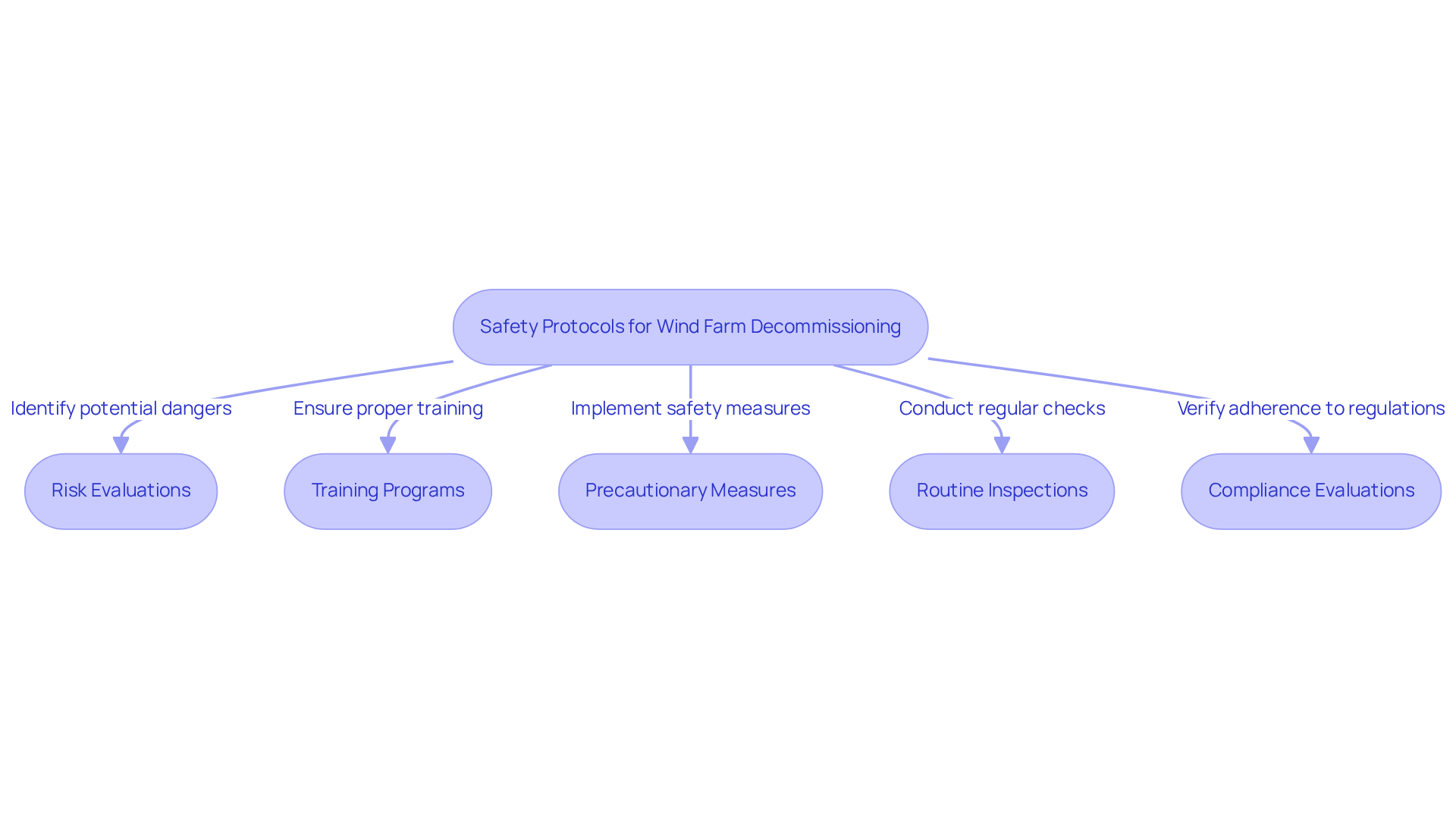
Conduct Environmental Assessments: Evaluating Impact Before Decommissioning
Before initiating the shutdown process, it is imperative to conduct thorough environmental evaluations to assess potential impacts on surrounding ecosystems and communities. These evaluations must encompass detailed studies of soil, water, and wildlife to identify risks linked to the removal of wind turbines and associated infrastructure.
Research indicates that removal activities can lead to habitat loss and increased underwater noise, with sound pressure spectral density levels during these activities being 30-40 dB higher than baseline, potentially affecting sensitive marine species.
Furthermore, employing advanced cutting techniques, such as the Cryogenic Cooling and Cutting System (CCCS), can significantly reduce operational time and costs, thereby minimizing disruptions during the dismantling process. By comprehensively understanding these impacts, project managers can formulate effective strategies to mitigate adverse effects while adhering to the decommissioning guidelines for wind farms and fostering sustainable practices in dismantling.
Additionally, it is vital to consider annual variations in seabird populations, as these changes complicate the assessment of impacts stemming from operational cessation. The necessity of conducting Environmental Impact Assessments (EIA) early in the planning stages is emphasized by case studies advocating for proactive evaluations to guide decision-making and design mitigation strategies.
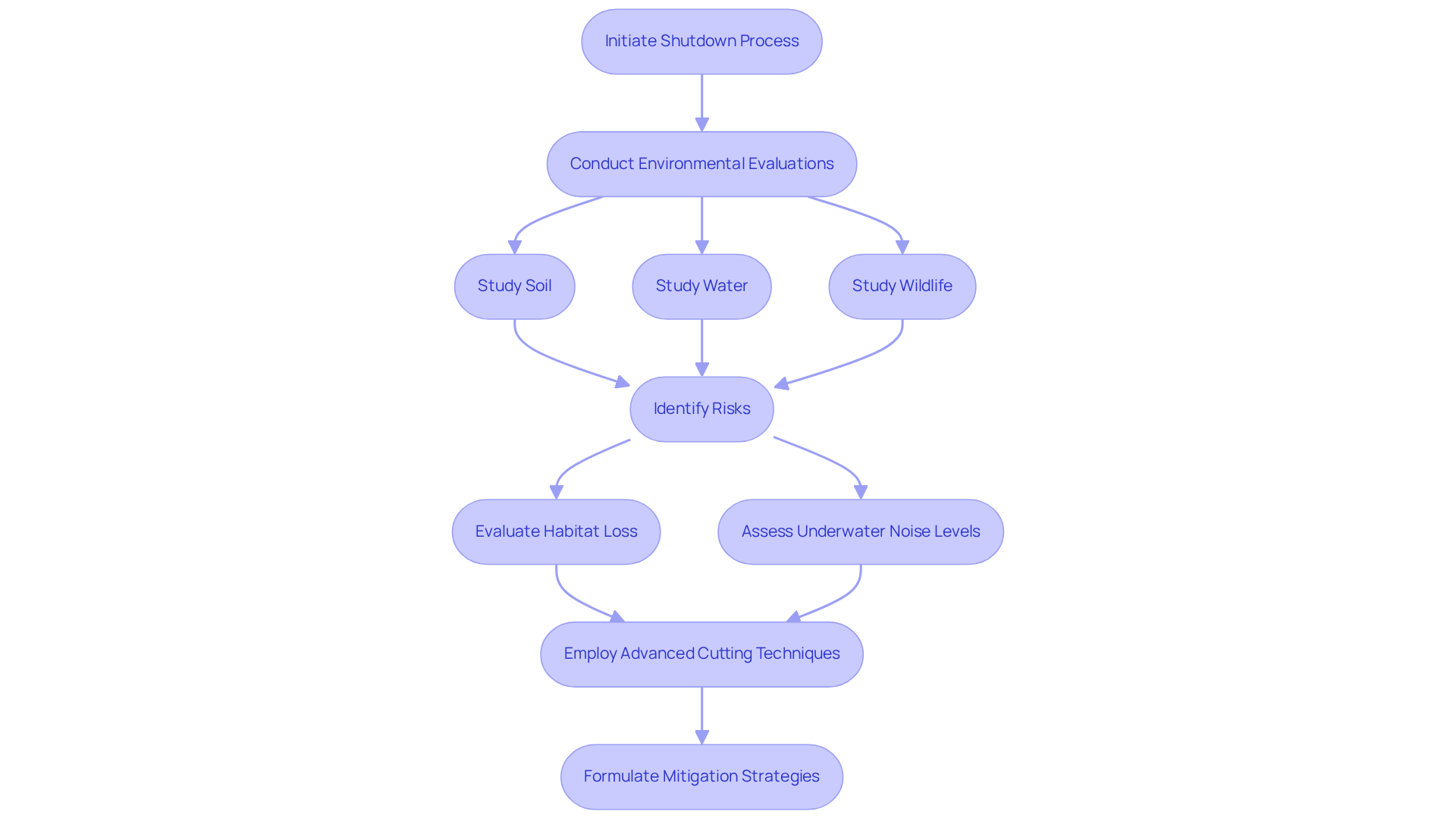
Engage Stakeholders: Involving Communities and Authorities in Decommissioning
Engaging stakeholders—local communities, government agencies, and environmental organizations—is essential for a successful dismantling process. This involvement not only addresses concerns but also builds trust among all parties. Early and transparent communication is key. By arranging public meetings, providing updates on closure plans, and actively soliciting feedback, organizations can significantly enhance community relations. Such proactive measures ensure that the closure process aligns with local interests and adheres to regulatory requirements.
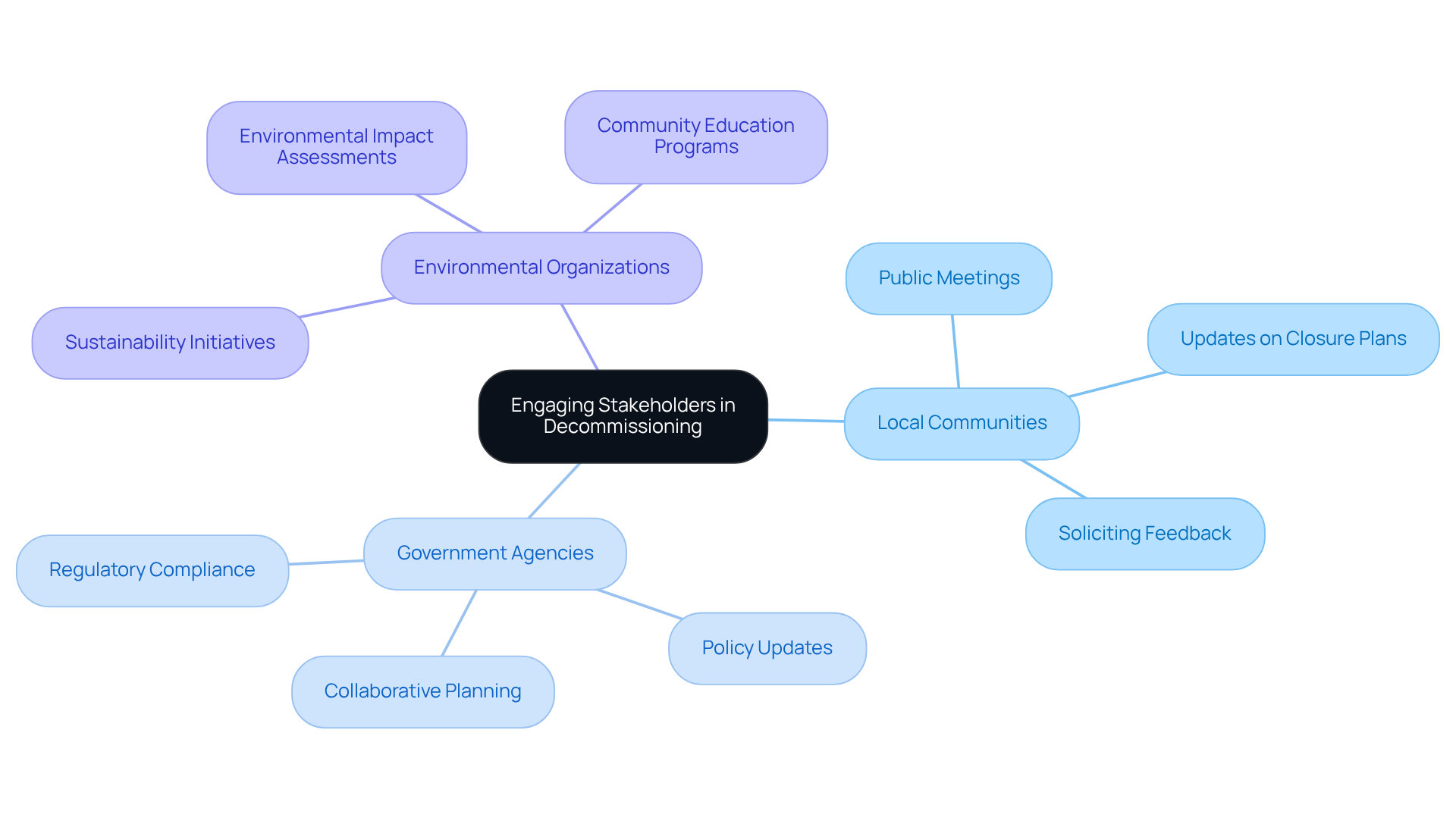
Develop a Decommissioning Plan: Creating a Roadmap for Wind Farm Closure
Establishing comprehensive decommissioning guidelines for wind farms is crucial for ensuring a systematic approach to the closure of renewable energy sites. This strategy must delineate the timeline, budget, and specific procedures for dismantling turbines, restoring the site, and managing waste based on the decommissioning guidelines for wind farms. Additionally, it should encompass:
- Regulatory compliance
- Environmental considerations
- Decommissioning guidelines for wind farms
- Strategies for engaging stakeholders
A well-defined strategy not only optimizes operations but also minimizes disruptions during the shutdown process.
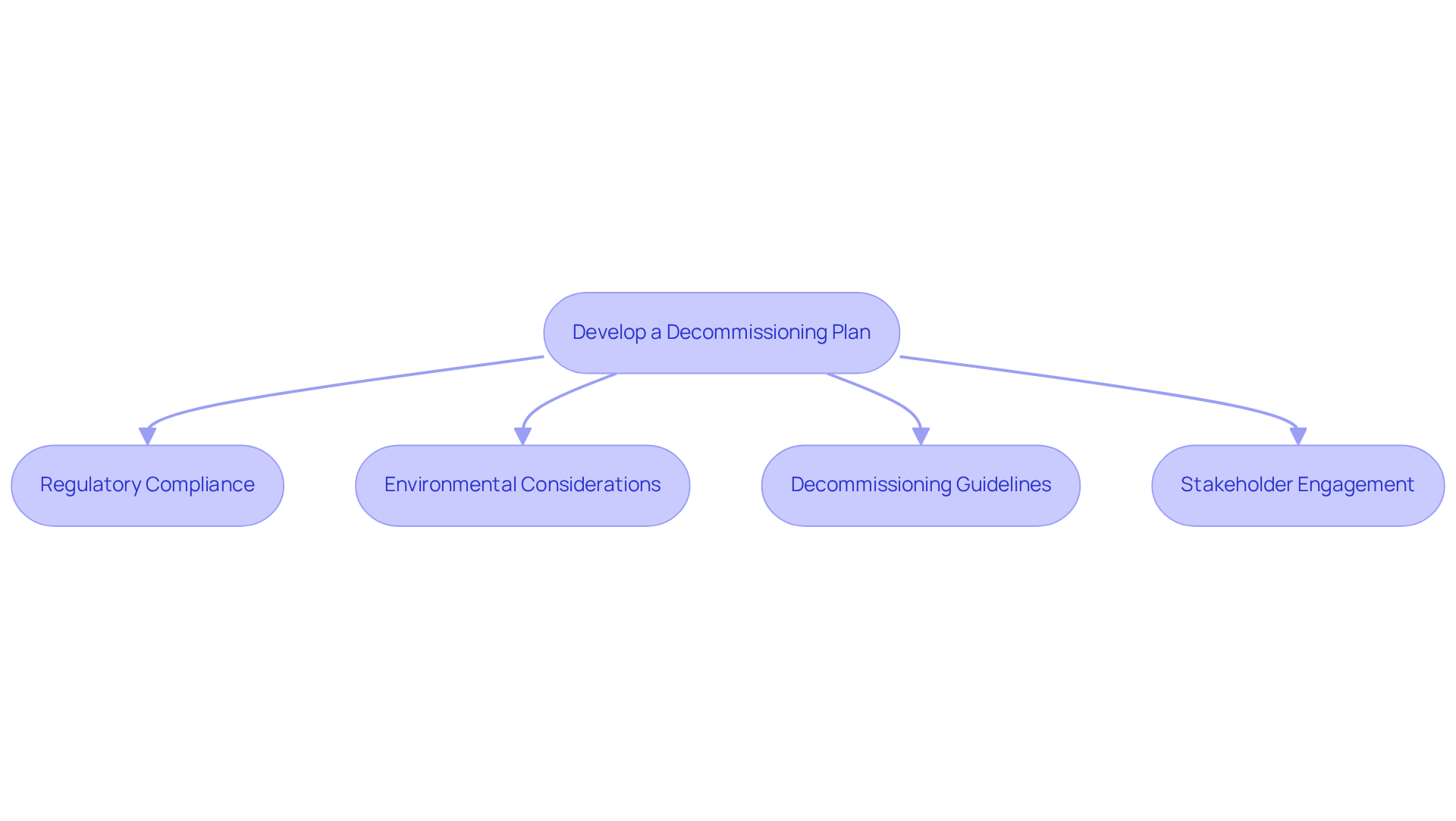
Implement Recycling Strategies: Maximizing Resource Recovery from Decommissioned Wind Farms
Implementing recycling methods during turbine removal significantly reduces waste and promotes sustainability. This approach involves recycling materials such as steel, concrete, and turbine components. Innovative recycling technologies can effectively repurpose turbine blades and other materials, thereby minimizing landfill use.
Establishing partnerships with recycling facilities and ensuring compliance with recycling regulations are crucial steps for maximizing resource recovery and minimizing environmental impact.
How can your organization leverage these practices to enhance sustainability efforts? By adopting these methods, you not only contribute to environmental preservation but also position your organization as a leader in responsible resource management.
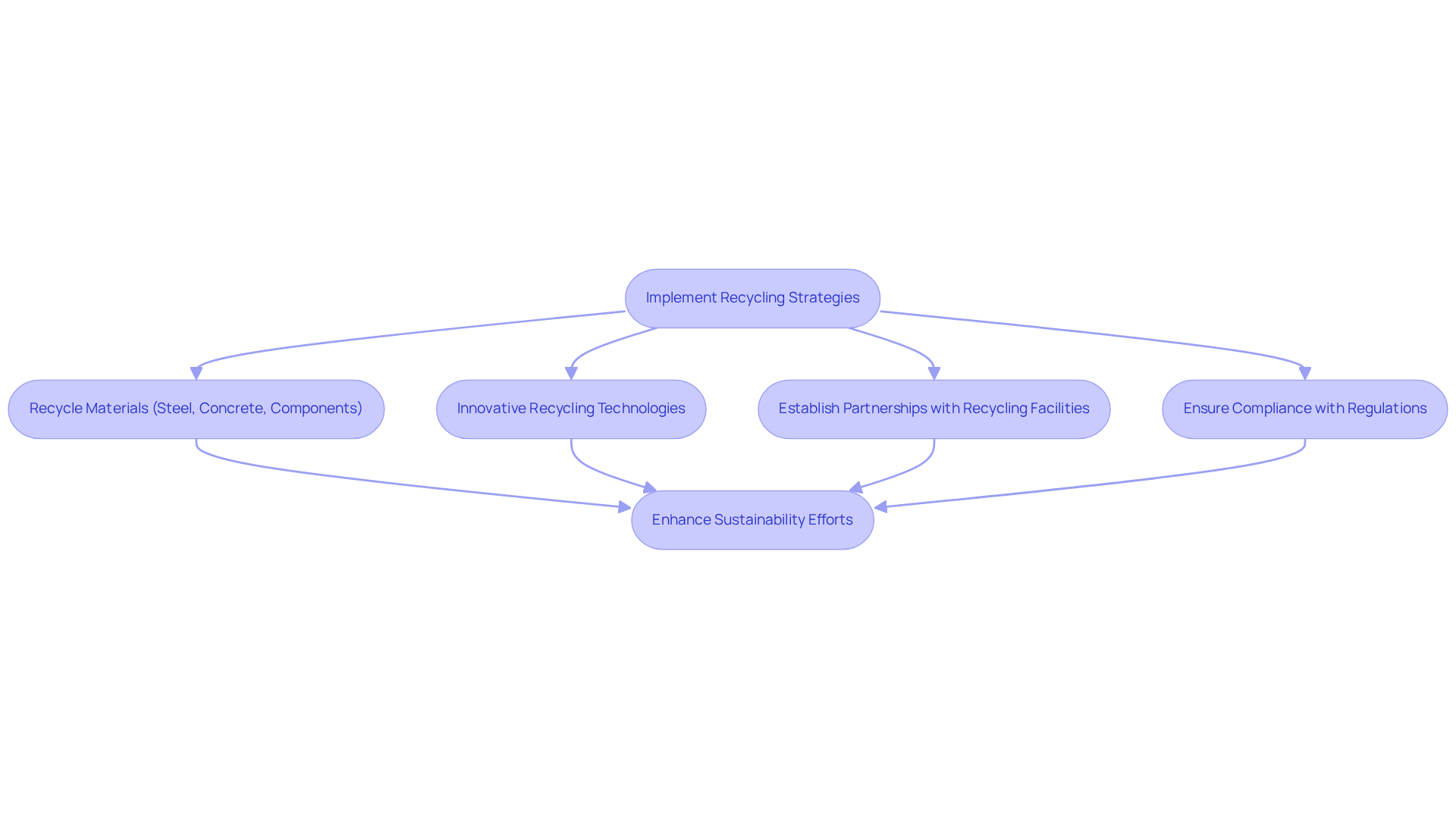
Ensure Proper Waste Disposal: Complying with Environmental Regulations
Proper waste disposal is critical in the shutdown of energy generation sites and must follow the decommissioning guidelines for wind farms, which demand strict adherence to local and federal environmental regulations. This process entails:
- Classifying waste types
- Determining appropriate disposal methods
- Maintaining comprehensive documentation to ensure compliance
Have you considered the risks associated with improper disposal? Engaging licensed waste disposal contractors is vital for the safe and responsible handling of hazardous materials, thereby minimizing the risk of environmental contamination.
As we approach 2025, staying informed about decommissioning guidelines for wind farms and evolving regulations concerning hazardous waste management is essential to ensure all removal activities align with best practices and legal obligations.
Given Harbinger Land's extensive experience serving a diverse array of clients, including natural gas companies and solar developers, their veteran team is adept at navigating these complexities efficiently.
To enhance compliance, consider implementing a regular review process for your waste management practices. This will ensure your team remains informed about the latest regulatory changes and best practices in hazardous waste management.
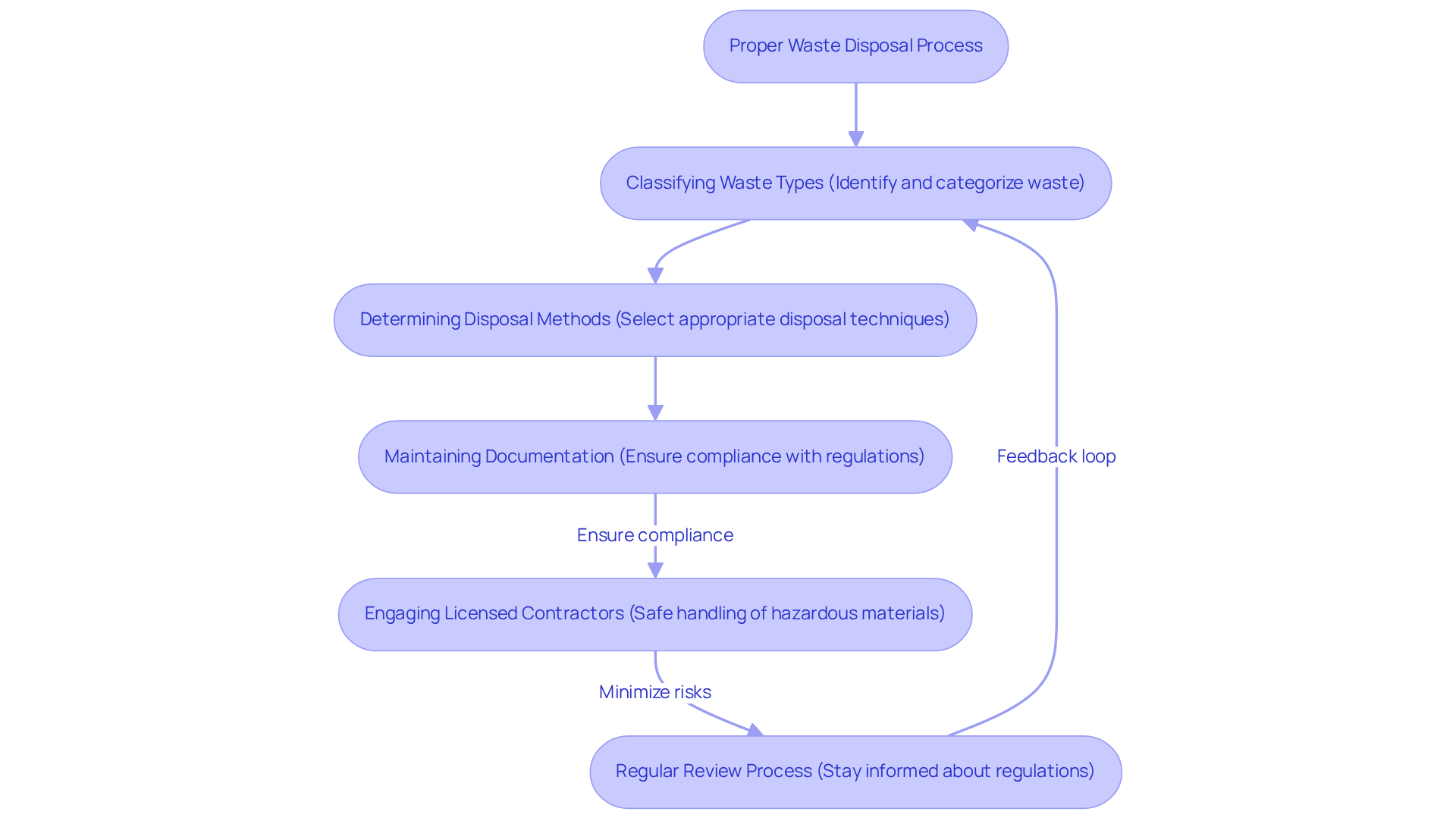
Leverage Technology: Utilizing Advanced Tools for Efficient Decommissioning
Advanced technology plays a pivotal role in enhancing the effectiveness of the decommissioning guidelines for wind farms during turbine site closure. The integration of tools such as:
- Drones for site surveys
- AI-powered software for project management
- GIS mapping for resource allocation
not only streamlines operations but also significantly improves accuracy. How can these technologies transform your processes? By enabling real-time monitoring, data analysis, and informed decision-making, they lead to more efficient decommissioning guidelines for wind farms. Embrace these innovations to overcome the complexities of land acquisition and regulatory challenges, ensuring a smoother closure experience.
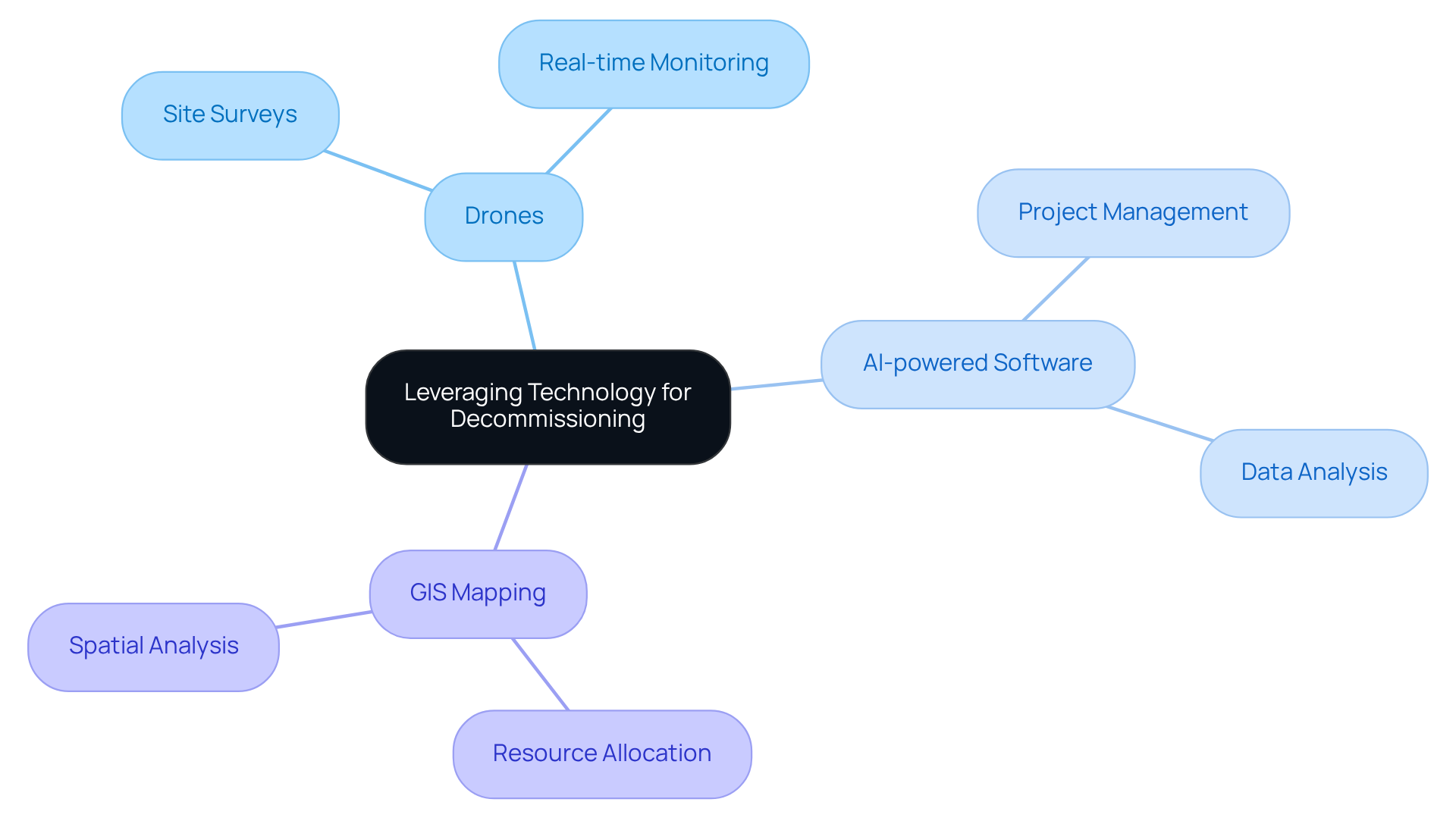
Train Personnel: Ensuring Competence in Decommissioning Operations
Educating staff engaged in wind farm removal is essential for ensuring security and operational effectiveness. Comprehensive training programs must encompass protocols for:
- Security
- Equipment handling
- Environmental regulations
- Emergency response procedures
Regular training sessions and certifications are vital to equip all team members with the necessary skills to navigate the complexities of dismantling operations. Effective safety training programs demonstrate a direct correlation between well-trained staff and improved safety outcomes, underscoring the critical role of expertise in shutdown operations as we approach 2025.
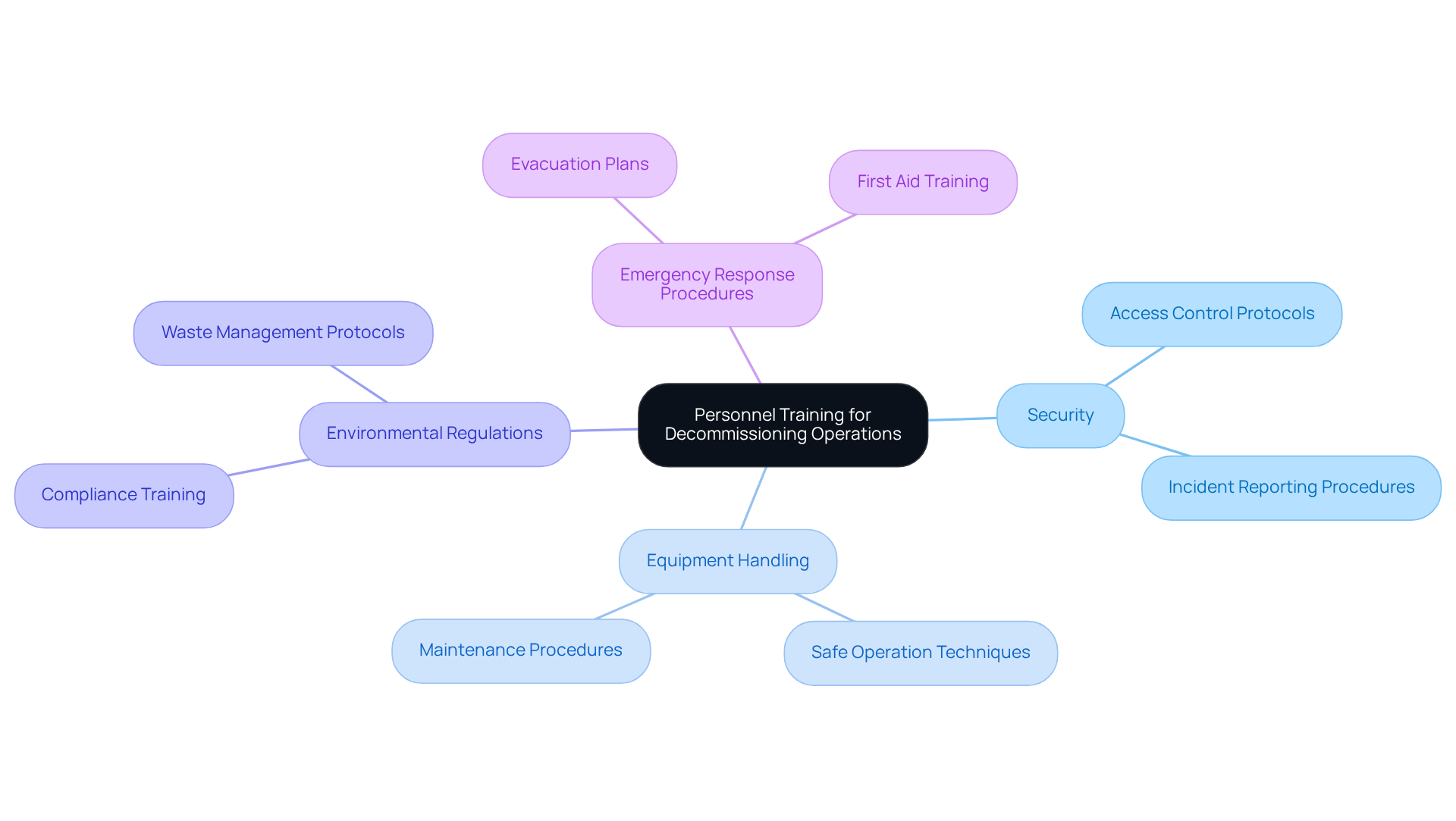
Conduct Post-Decommissioning Monitoring: Assessing Long-Term Environmental Impact
According to the decommissioning guidelines for wind farms, post-decommissioning monitoring is essential for evaluating the long-term environmental impacts of wind farm closures. Regular evaluations of soil, water quality, and local ecosystems are crucial to ensure the success of restoration efforts and address any potential negative consequences.
A well-developed monitoring plan that specifies metrics, timelines, and responsibilities is vital for ensuring compliance with the decommissioning guidelines for wind farms and environmental regulations. This proactive approach promotes sustainable land use following decommissioning, ultimately safeguarding our natural resources.
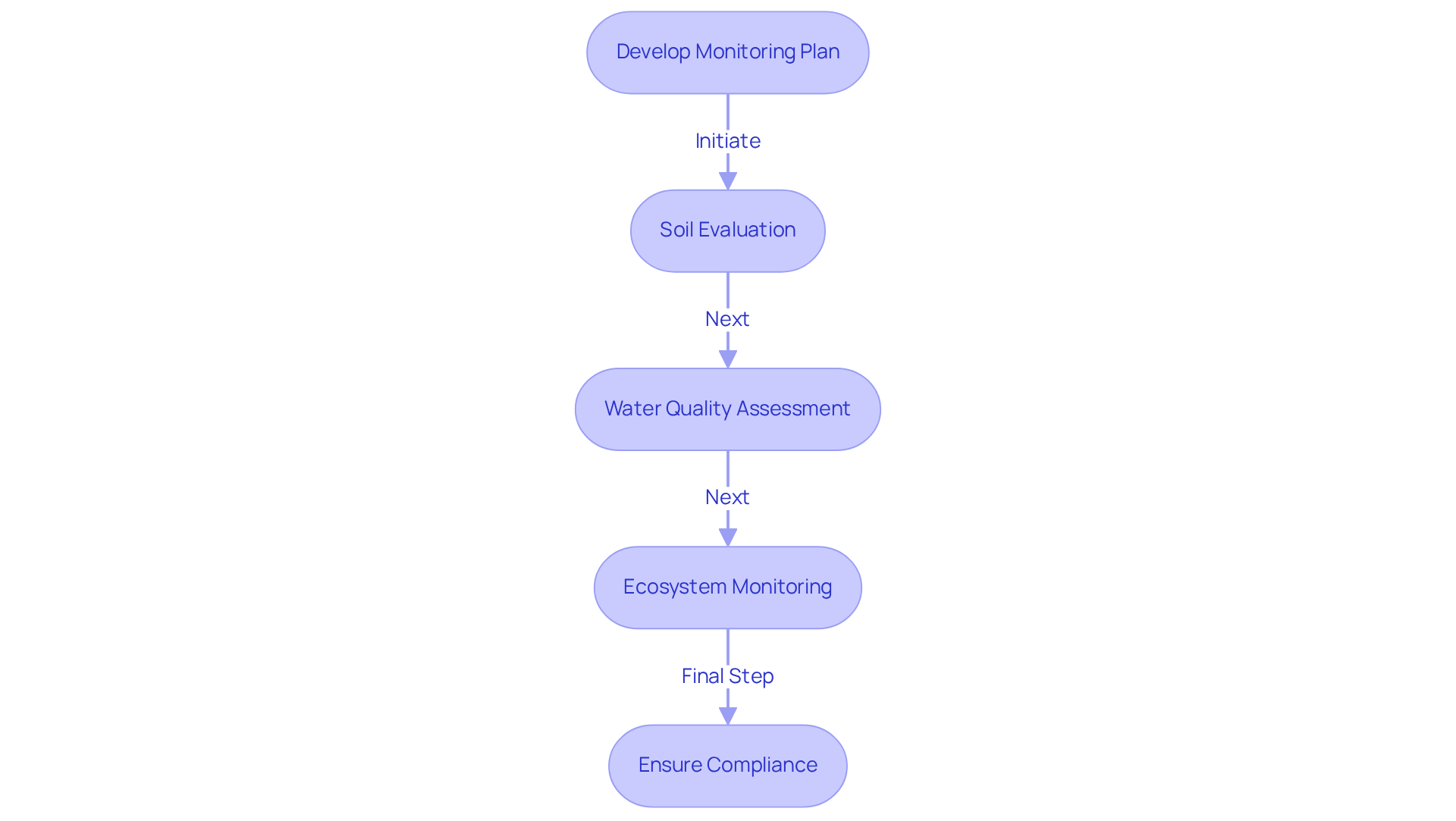
Conclusion
The decommissioning of wind farms represents a complex challenge that requires meticulous planning, strict adherence to safety protocols, and a steadfast commitment to environmental stewardship. By following the crucial guidelines outlined here, energy producers can effectively navigate the intricacies of dismantling operations, ensuring compliance with regulations while safeguarding community interests.
Engaging stakeholders, conducting thorough environmental assessments, and implementing effective recycling strategies are vital components of this process. Furthermore, leveraging advanced technologies and training personnel are essential for enhancing operational efficiency and safety during decommissioning. These practices not only mitigate risks but also promote sustainability and responsible resource management.
As the industry approaches 2025, the importance of these decommissioning guidelines is paramount. A proactive approach to planning, safety, and environmental impact will protect workers and ecosystems alike, contributing to the broader goal of sustainable energy practices. By embracing these essential steps, we can ensure that the transition from operation to closure is executed with care, responsibility, and foresight.
Frequently Asked Questions
What services does Harbinger Land provide for wind farm decommissioning?
Harbinger Land offers a comprehensive suite of services including site and right-of-way acquisition, advanced title research, GIS mapping, and efficient data processing.
How does Harbinger Land enhance efficiency in land management for wind farm decommissioning?
They leverage cutting-edge technology such as AI-powered title research software and integrated GIS modeling services to improve efficiency and accuracy in managing land-related challenges.
Why is GIS mapping important in the decommissioning process?
GIS mapping provides enhanced visibility into all facets of a project, facilitating real-time decision-making for energy producers and stakeholders.
What safety protocols are essential during wind farm decommissioning?
Essential safety protocols include extensive risk evaluations, detailed training programs, strict precautionary measures like fall protection systems, emergency response plans, and routine inspections to ensure compliance with regulations.
What incident highlights the importance of safety in wind farm decommissioning?
The tragic incident at Orsted's Plum Creek wind farm, where two maintenance workers lost their lives due to equipment failure, underscores the critical need for strict protective measures and commitment to safety.
Why are environmental assessments necessary before decommissioning wind farms?
Environmental assessments are crucial to evaluate potential impacts on ecosystems and communities, including studies of soil, water, and wildlife to identify risks associated with the removal of wind turbines and infrastructure.
What advanced techniques can reduce operational time and costs during decommissioning?
The use of advanced cutting techniques, such as the Cryogenic Cooling and Cutting System (CCCS), can significantly reduce operational time and costs, minimizing disruptions during the dismantling process.
How do annual variations in seabird populations affect environmental assessments?
Annual variations in seabird populations complicate the assessment of impacts from operational cessation, emphasizing the need for thorough Environmental Impact Assessments (EIA) early in the planning stages.
List of Sources
- Adhere to Safety Protocols: Essential Practices for Wind Farm Decommissioning
- Offshore Wind Can’t Be Allowed to Blow Off Decommissioning Like Fossil Fuel Industry Did - ecoRI News (https://ecori.org/offshore-wind-cant-be-allowed-to-blow-off-decommissioning-like-fossil-fuel-industry-did)
- UPDATED: Fatalities at Orsted US wind farm (https://renews.biz/99003/us-police-probe-fatalities-at-nebraska-wind-farm)
- THE DARK SIDE OF “GREEN”: WIND TURBINE ACCIDENTS, INJURIES AND FATALITIES RAISE SERIOUS SAFETY CONCERNS | East County Magazine (https://eastcountymagazine.org/dark-side-“green”-wind-turbine-accidents-injuries-and-fatalities-raise-serious-safety-concerns)
- What happens when wind turbines get old? New Industry Guidance Document for dismantling and decommissioning (https://windeurope.org/newsroom/press-releases/what-happens-when-wind-turbines-get-old-new-industry-guidance-document-for-dismantling-and-decommissioning)
- Wind Energy’s Dirty Word: Decommissioning | Texas Law Review (https://texaslawreview.org/wind-energys-dirty-word-decommissioning)
- Conduct Environmental Assessments: Evaluating Impact Before Decommissioning
- Environmental Impact Assessment for the decommissioning of offshore wind farms | Request PDF (https://researchgate.net/publication/360851776_Environmental_Impact_Assessment_for_the_decommissioning_of_offshore_wind_farms)
- Ensure Proper Waste Disposal: Complying with Environmental Regulations
- Wind Energy’s Dirty Word: Decommissioning | Texas Law Review (https://texaslawreview.org/wind-energys-dirty-word-decommissioning)
- Train Personnel: Ensuring Competence in Decommissioning Operations
- VR Training for High-Voltage Test Devices (https://atsindustrialautomation.com/case_studies/vr-training-for-high-voltage-test-devices)




